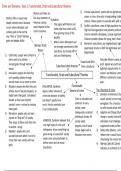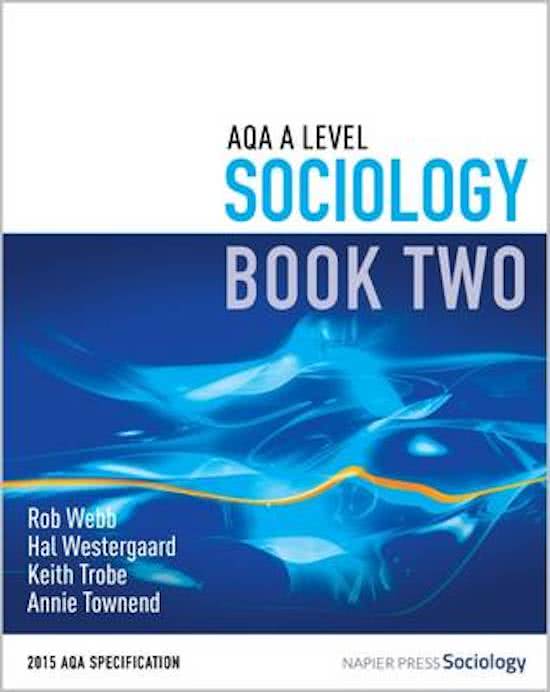Crime and Deviance: Topic 1: Functionalist, Strain and Subcultural theories
Merton said there are 1) Criminal subcultures: youths with an apprentices
Merton offers a reason why five ways members of Evaluation: career in crime. Arise only in longstanding stable
people commit crime. Deviance American society cultures. Allows youths to associate with adult cr
• They agree with Merton and 2) Conflict subcultures: areas of high population tur
occurs when individuals cant could respond to this Cohen that most crime is WC,
strain to anomie High level disorganization and prevents professio
achieve goals in the normal thus ignoring crimes of the
way. There is "strain" between criminal networks developing. Loosely organized
wealthy Violence provides release for young men's frustra
goals and people ability • Matza: claims delinquents are 3) Retreatism subcultures: any neighborhood, legiti
Merton: Strain not strongly committed to their opportunity structure. Both fail legitimately and
theory subculture, but merely drift in illegitimately
1) Conformity: people who conform to and out of delinquency
norms and try to achieve They take Merton's ideas as
Cloward and Ohlin:
success/goals through normal point. Agreed wc youths are
Subcultural strain theories three subcultures
means legitimate opportunities to a
2) Innovation: people who feel they success' and deviance stems
Functionalist, Strain and Subcultural Theories Different subcultures respon
can't possibly achieve through
normal means so try resort to crime ways.
3) Ritualism: people who feel they cant EVALUATION :Durkheim Functionalist
achieve due to few job prospects, so Argues certain amount of theories of crime The 4 functions of crime:
might lower their goals. Considered crime and deviance is healthy 1) Boundary maintenance (Du
deviant as they have rejected but doesn’t specify how Crime is inevitable and causes society to come toge
society's norms + values by creating much. He also overlooks how universal. In every wrongdoer. This a function o
lower goals it can isolate people society, some to refim shared values reinf
4) Retreatism: people who cant earn inadequately socialized 2) Adaption and Change (Durk
success so "drop out" of society. individuals deviate. All change is society starts with
HOWEVER, Durkheim believed that society needs individuals must challenge n
They resign to failure and often turn
very high levels of crime and progress, and all social suppressed society will be s
to alcohol + drugs
delinquency shows something has change begins with a 3) Safety Valve (Davies) - prost
5) Rebellion: people who can't
gone wrong in society BUT society deviation from norms. release men's sexual frustra
succeed but wont admit it so try to
needs crime and punishment to threatening the nuclear fam
create their own society with new
define norms and set moral 4) Warning Light (A.K.Cohen) -
goals
boundaries indicates an institution is m
,Crime and Deviance: Topic 2: Interactionalism and Labelling Theory
The dark figure of crime: difference between the official stat
Whether a person is arrested, charges and convicted depends on: and the "real" rate of crime called the dark figure, as we don
▪ Interactions with agencies of social control how much crime goes undetected, unreported and unrecord
▪ Appearance, background and personal biography People may exaggerate ,
▪ The situation and circumstances of the offense forget or conceal info Outcome depends on the lab
At each stage of criminal attached by the typification's
Piliavin & Briar: found police decision Alternative statistics: victim justice, agents of social stereotypes they hold about
to arrest youths were mainly based on surveys or self-report control make decisions
physical cues from which they made studies to gain a more about whether or not to Statistics produced only tell u
judgements around their character accurate view of quantity of procced to the next stage activities of the police and pr
crime. Add to picture of rather than about the amoun
crime but have limitations in society and who commits
Instead, we should treat them as a topic to The social construction of
be investigated. We shouldn’t take them at crime statistics
face value but investigate the processes that Who gets Platt: argues that the
created them. Sheds light on activities of labelled?
The Social Construction of Crime
of "juvenile delinquen
the control agencies and how they process was originally created
and label people as criminal Cicourel: the a result of a campaign
Topic vs In Cicourel's view, justices is not
negotiation of justice fixed but negotiable. But if the upper-class Victorian
Cicourel's study has Resource
person doesn't fit the polices moral entrepreneurs
implications for the use we Found that officers typification- aimed at protecting a
idea of "typical delinquent" is
make of official crime statistics their commonsense theories or risk young people.
less likely to be charged and will
recorded by the police stereotypes of what the typical
be counselled, warned and
delinquent is like – led them to
released rather than prosecuted
concentrate on certain "types" Becker: a deviant is s
Argues the statistics don’t give a someone to whom t
picture of the patterns of crime and Resulted in law enforcement showing a class bias e.g. probation has been successfull
cannot be used as a resource (fact) officers held the commonsense theory that juvenile delinquency and deviant behavio
caused by broken homes, lack of parenting and poverty behavior that people
, Crime and Deviance: Topic 2: Interactionalism and Labelling Theory Deviance amplification spiral: te
Young: concept of secondary deviance people attempt to control devian
Secondary deviance: result
Vandalism, alcohol use, littering and a deviant career in his study of increasing it
of societal reaction – that
is of labelling. Being caught weed us in Nottinghill. Drugs were are
Primary deviance: deviant acts part of hippie lifestyle (primary) but This further marginaliz
and publicly labelled as a resulting in more devia
that have not been publicly criminal can involve being persecution and labelling by control
labelled. Argues its pointless to stigmatized, shamed, culture led hippies to be considered
outsides Cohen: study of societal reacti
seek the causes of primary humiliated and shunned.
deviance, so widespread that its "mods and rockers" disturban
Criminal becomes their Secondary deviance is likely to provoke groups of youths at English Sea
unlikely to have a single cause "master status" further hostile reactions from society Press caused a moral panic peo
and reinforce the deviant's "outsider" "crackdown" so police arrested
Lemert: distinguishes between Primary and
status. This can lead to more deviance while the courts imposed hars
primary and secondary deviance secondary deviance
and a deviant career
Deviance Folk devil
Illustrates the idea that it is not the act itself, but the The Effects of Labelling amplification Spiral dark fi
hostile societal reaction to it that creates serious deviance
Labelling and Criminal Labelling theory implies Folk devils are the opposite of
Braithwaite: identifies a more Reintegrative we need to avoid figure. The dark figure is about
justice policy
positive role of the labeling process: shaming "publicly naming and crime that’s ignored, folk devil
1) Disintegrative shaming: where shaming" offenders, actions are "overly labelled"
not only the crime, but also the Studies show that increases
since this is less likely to
criminal, is labelled as bad and in control and punish young
create a perception of The pursuit of folk
the offender is excluded by offenders has the opposite
them as evil outsider draws resources a
society (public humiliation) effect
2) Reintegrative shaming: labels detecting and pun
These findings indicate that labelling theory has
the act but not the actor- "he Triplett: an increasing tendency crimes that make
important policy implications. Negative labelling
has done a bad thing" rather in the USA to see young figure, such as crim
pushes offenders towards a deviant career. So, to
than "he is a bad person" offenders as evil and to be less powerful
reduce deviance we should make and enforce
tolerant of minor deviances
less rules for people to break





